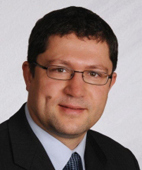
Fachgebiet:
Mustererkennung, Industrielle Bildverarbeitung, Computergestützte Intelligenz
Arbeits- und Forschungsgebiete:
- Adaptive Signalanalyse (Anerkannter Forschungsschwerpunkt der Hochschule Schmalkalden)
- Computergestützte Intelligenz: Support-Vektor-Maschinen; Prototyp-Vektorbasierte-, Rückgekoppelte-, Selbstorganisierende- Netze; Evolutionäre Methoden, Empirische multikriterielle Parameteroptimierung
- Signalverarbeitung: lineare / nichtlineare; deterministische / stochastische Analysen im Originalbereich; Spektralbereich; Zeit-Frequenzbereich; Zustandsraum
- Anwendungsbereiche: Humanfaktoren, Biomedizintechnik, Industrielle Bild- und Signalerkennung, Data Mining
- Hardwarenahe Entwicklung in Verbindung mit Mustererkennung, Bildverarbeitung und Computergestützter Intelligenz
- Konzeption und Entwurf von Web-Applikationen: Online-Evaluation, Bewertung von Schichtarbeit, CXF-Webservices
Ausgewählte Publikationen:
- Sommer D, Golz M, Schnupp T, Trutschel U, Edwards D (2010) PERCLOS as a Fatigue Measure - A Look on Current Fatigue Monitoring Technologies. Proc 44th Ann Conf Biomed Technol DGBMT-2010
- Golz M, Sommer D, Trutschel U, Sirois B, Edwards D (2010) Evaluation of Fatigue Monitoring Technologies. J Somnol 14 (3) 187-9
- Sommer D, Golz M, Schnupp T, Krajewski J, Trutschel U, Edwards D (2009) A Measure of Strong Driver Fatigue. Proc Int Conf on Driving Assessment, Big Sky MT, USA: 9-15
- Golz M, Sommer D (2008) Automatic Knowledge Extraction: Fusion of Human Expert Ratings and Biosignal Features for Fatigue Monitoring Applications. In: Mandic D, Golz M, Kuh A, Obradovic D, Tanaka T (eds) Signal Processing Techniques for Knowledge Extraction and Information Fusion. Springer, New York, ISBN 0-387-74366-9 : 297-314
- Golz M, Sommer D, Chen M, Trutschel U, Mandic DM (2007) Feature Fusion for the Detection of Microsleep Events. J VLSI Signal Proc Syst 49: 329-42
- Sommer D, Golz M (2006) A Comparison of Validation Methods for Learning Vector Quantization and for Support Vector Machines on Two Biomedical Data Sets. In: Spiliopoulou M, et al (eds) From Data and Information Analysis to Knowledge Engineering. Springer, Berlin, ISBN 3-540-31313-3 : 150-7
- Sommer D, Chen M, Golz M, Trutschel U, Mandic D (2005) Fusion of State Space and Frequency-Domain Features for Improved Microsleep Detection. In: Duch W et al (eds) Int Conf Artif Neur Netw (ICANN-2005); LNCS 3697, Springer, Berlin:753-9
- Sommer D, Golz M (2002) Detection of Wake-Sleep Transitions with Prototype Vector-Based Neural Networks. Int J Knowl Base Intell Eng Syst, KES International, University of Brighton, United Kingdom, ISSN 1327-2314:
Weitere Veröffentlichungen: http://sund.de/publications
Werdegang:
- 1993 - 1998 Studium der Informatik an der Fachhochschule Schmalkalden; Vertiefungsgebiete: Datenbanksysteme, Datenschutz, Hardwarenahe Systeme, Rechnernetze und verteilte Systeme, Wissensverarbeitung und Neuroinformatik
- 1998 Diplomarbeit: Klassifikation von reizbezogenen EEG-Mikroepochen. Abschluss: Diplom-Informatiker (FH)
- 1999 - 2000 Studium der Informatik an der TU Ilmenau Abschluss: Promotionseignungsprüfung
- Seit 1998 Wissenschaftlicher Mitarbeiter an der Fachhochschule Schmalkalden
- Seit 2002 Dozent für die Fächer: Mustererkennung, Neuroinformatische Methoden, Statistik und Qualitätsmanagement
- Seit 2005 Firma: Softwareentwicklung, Datenanalyse mit Künstlichen Neuronalen Netzen, 22 Projekte für Industrieunternehmen
- 2009 Promotion an der TU Ilmenau, Thema der Arbeit: Analyse des Mikroschlafs mit Methoden der Computergestützten Intelligenz.
- 2009 STIFT-Preis 2009 für anwendungsorientierte Forschung
